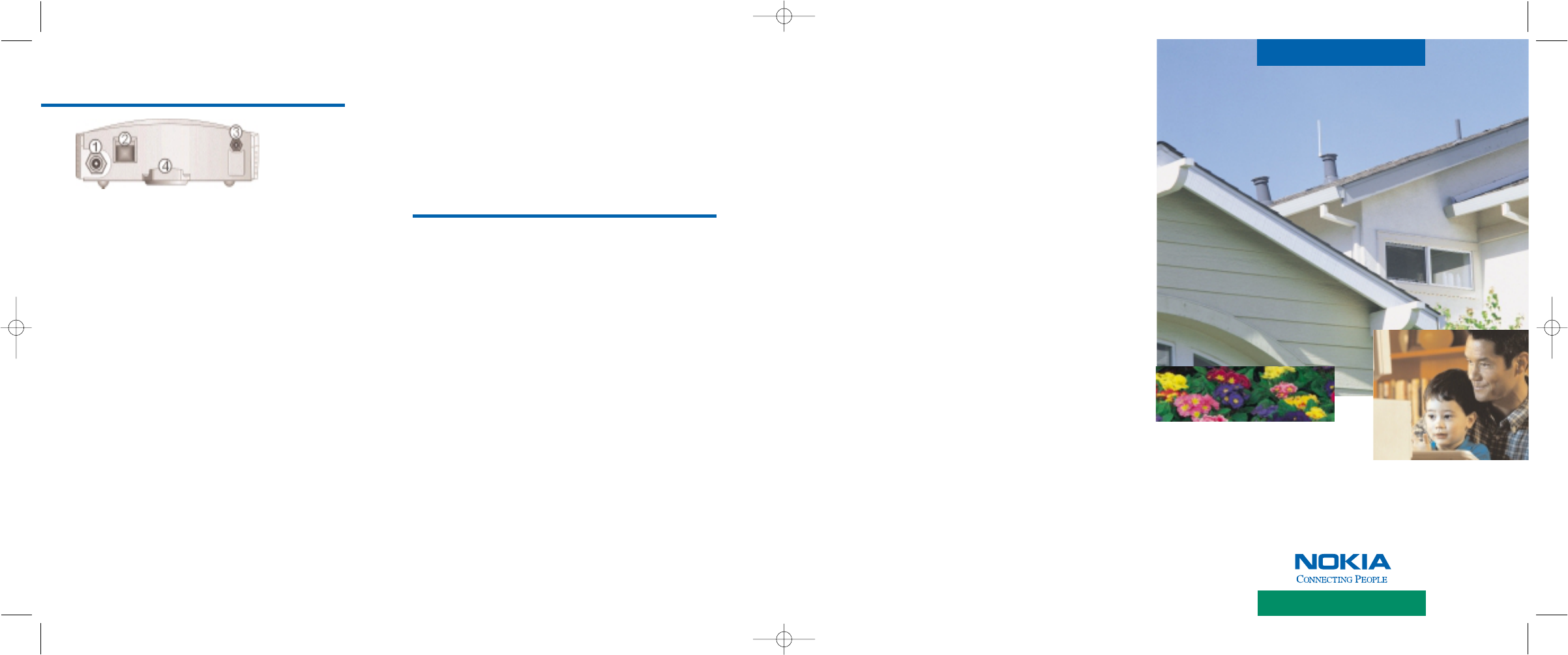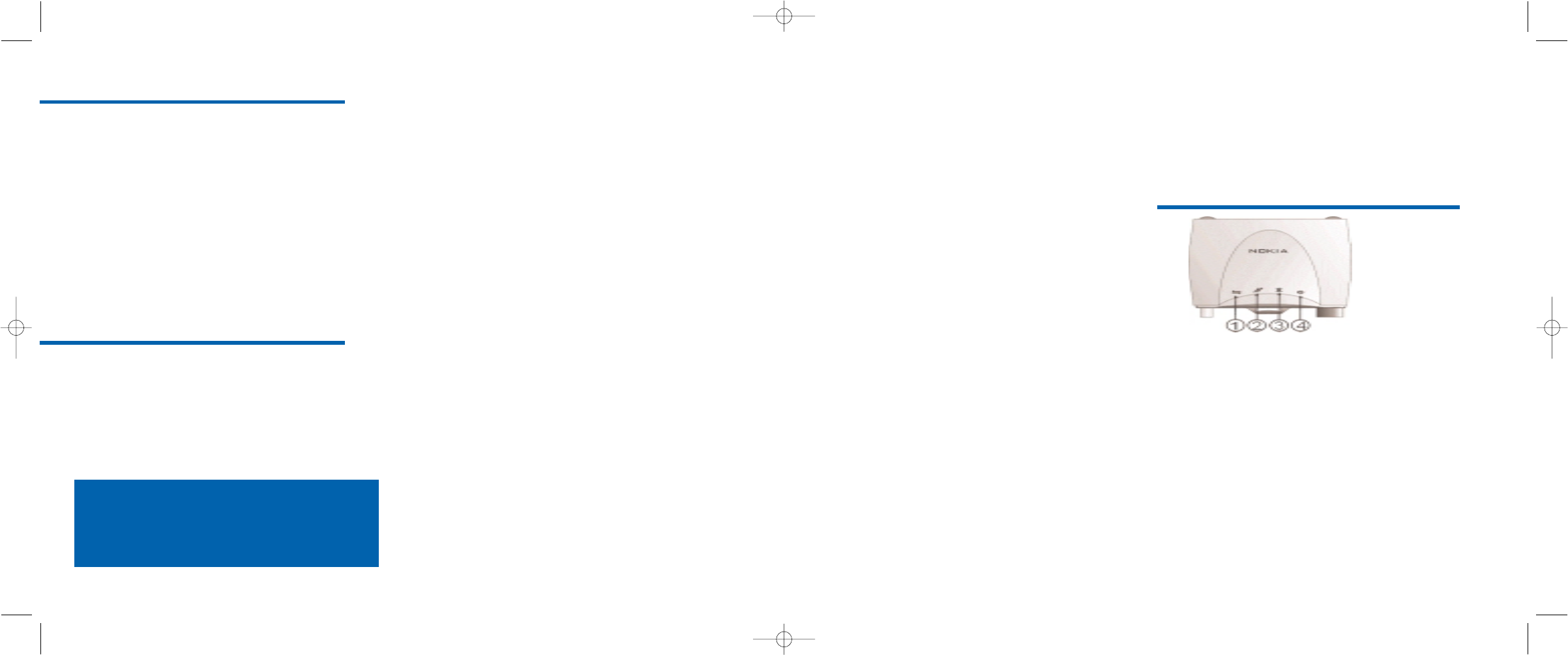Nokia Networks R242-V01 Rooftop Spread Spectrum Wireless Router User Manual Revised Users
Nokia Networks Inc Rooftop Spread Spectrum Wireless Router Revised Users
Contents
- 1. Revised Installation
- 2. Revised Users
Revised Users

Wireless Router Subscriber Guide
Bottom Panel
Bottom Panel Connections
1. Antenna Connection: This connector connects directly to an antenna or to RF
cable connected to an antenna. The connector is a TNC female connector.
2. Ethernet Interface: A standard 10/100 BaseT Ethernet jack.
3. Power Port: Connects the Nokia RoofTop Wireless Router to the 12VDC
power connector.
NOTE: Use only the power device provided with the unit.
4. Strain Relief: For the 12VDC power cable
Connecting the Wireless Router to
Your PC or LAN
Your wireless router is capable of providing Internet access for a single PC via a
direct connection or to multiple PC’s via a local area network (LAN).
Direct Connection: When connecting your wireless router to a single PC, con-
nect the Ethernet port on the wireless router and the network interface on your
PC with a "crossover" Ethernet cable.
LAN Connection: When connecting your wireless router to multiple PCs via a
hub, router, or switch, use standard "straight-through" Ethernet cables throughout
the entire network.
NOTE: Nokia RoofTop Wireless Routers are capable of providing Internet access
for multiple PCs, however the actual number of PCs that can receive Internet
connectivity via your wireless router will depend on the level of service you
purchased from your Internet Service Provider.
Technical Support
Nokia provides technical support only for network operators and authorized
resellers. Technical support for subscribers to a Nokia network is provided by your
Internet Service Provider. If you experience problems with your service or have
any questions regarding the performance of your wireless router, please contact
the ISP that installed the equipment.
Disclaimer
Nokia is the manufacturer of the wireless router and provides no warranty service
and repair. Nokia RoofTop Wireless Routers are Provided "AS IS" with no warranty.
NOKIA DISCLAIMS ALL WARRANTIES, EXPRESS OR IMPLIED, INCLUDING THE
IMPLIED WARRANTY OF MECHANTABILITY AND FITNESS FOR PARTICULAR
PURPOSE. NOKIA SHALL NOT BE LIABLE FOR SPECIAL, INCIDENTAL, PUNITIVE
OR CONSEQUENTIAL DAMAGES, INCLUDING BUT NOT LIMITED TO LOSS OF
ANTICIPATED BENEFITS OR PROFITS, LOSS OF SAVINGS OR REVENUE, PUNITIVE
DAMAGES, LOSS OF USE OF THE PRODUCT OR ANY ASSOCIATED EQUIPMENT,
COST OF CAPITAL, COST OF ANY SUBSTITUTE EQUIPMENT OR FACILITIES, DOWN-
TIME, THE CLAIMS OF ANY THIRD PARTIES, INCLUDING CUSTOMERS, AND INJURY
TO PROPERTY, RESULTING FROM THE PURCHASE OR USE OF THE PRODUCT OR
ARISING FROM BREACH OF THE WARRANTY, BREACH OF CONTRACT, NEGLIGENCE,
STRICT TORT, OR ANY OTHER LEGAL OR EQUITABLE THEORY, EVEN IF NOKIA
KNEW OF THE LIKELIHOOD OF SUCH DAMAGES. NOKIA SHALL NOT BE LIABLE
FOR DELAY IN RENDERING SERVICE UNDER THE LIMITED WARRANTY, OR LOSS
OF USE DURING THE PERIOD THAT THE PRODUCT IS BEING REPAIRED.
If you experience any problem or malfunction of the wireless router, please
contact the ISP that installed the equipment.
COPYRIGHT
© 2000 Nokia Corporation. All rights reserved.
Rights reserved under the copyright laws of the United States.
RESTRICTED RIGHTS LEGEND
Use, duplication, or disclosure by the Government is subject to restrictions as set forth in
subparagraph (c)(1)(ii) of the Rights in Technical Data and Computer Software clause at
DFARS 252.227-7013.
TRADEMARKS
Nokia and Nokia RoofTop are registered trademarks of Nokia Corporation.
Other products mentioned in this document are trademarks or registered trademarks of
their respective holders.
REGULATORY INFORMATION
This equipment has been tested and found to comply with the limits for a Class B digital device,
pursuant to Part 15 of the FCC rules. These limits are designed to provide reasonable protection
against harmful interference in a residential installation. This equipment generates, uses, and can
radiate radio frequency energy and, if not installed and used in accordance with the instructions,
may cause harmful interference to radio communications. However, there is no guarantee that
interference will not occur in a particular installation. The antennas used for this transmitter may not
This equipment must be installed by a professional installer.
End User Card Comp 1-REV 8/4/00 1:51 PM Page 1
be co-located or operating in conjunction with any other antenna or transmitter.

Service Only by Qualified Service
Personnel
• Do not open the unit, reconfigure the software or change power supplies.
• The user should not make any attempt to service the wireless router.
• The unit should be serviced only by qualified service personnel.
Front Panel
Front Panel View
The front panel indicators provide a quick check of the status of the wireless
router and its connections. The LEDs are labeled from left-to- right as follows:
1. Ethernet LAN - shows the local area network activity.
2. Radio - shows both transmit and receive radio activity.
3. Anchor - shows status in network and gives RF link information. If this light
is off you do not have the connectivity to the network.
4. Power Indicator - Steady light indicates the unit is powered on.
Introduction
Your Nokia RoofTop™ Wireless Router is a revolutionary new product, delivering
high-speed wireless Internet access.
Nokia RoofTop Wireless Routers combine an RF modem with a digital IP router
board and specialized wireless routing system, the Nokia AIR Operating System
(OS). This combination creates an IP router that is “wireless and intelligent.”
Your Nokia RoofTop Wireless Router not only provides you with fast “always-on”
Internet access, but is also an integral part of the network infrastructure. Some
routers may rely on others to reach the Internet. It is very important that your
wireless router is always powered ON, even when you are not using it, as it may
be forwarding and routing traffic for other routers in the network.
Warnings, Safety Instructions
and Technical Support
Important User Information
The Nokia RoofTop Wireless Router was designed and manufactured to meet
strict quality and safety standards. It complies with the FCC rules, Part 15 and
with 21 CFR 1040.10 and 1040.11.
This wireless router and its associated components are Class B devices that
must be installed and/or moved by a professional.
Accessories
• Use only Nokia approved accessories for all installations.
Cleaning the Unit
• Clean the wireless router with a dry cloth or paper towel.
Do not use any liquids to clean the unit.
Wireless Router Mounting
• Install the wireless router on a wall or on a desktop only in its special mounting
holder, which provides ventilation and helps protect against spilled liquids.
Ventilation Openings
• The small openings on the bottom and sides of the unit provide necessary
ventilation for the proper operation of the unit. Install the unit so that its
location or position does not interfere with this ventilation.
• Take precautions so that small objects are not dropped into the ventilation
openings.
Power
•Power Unit- Place the DC power unit out of the way, or tape it to the
side of a vertical surface to prevent it from being stepped on or damaged.
•Power Cords- Cords should be routed so that they are not likely to be walked
on or pinched by items placed on or against them. Pay particular attention to
the point where cords, plugs, and convenience receptacles exit the unit. The
DC cord should be placed in the strain relief to avoid accidental disconnection.
Interference
• The wireless router can cause interference to (and interfere with) other
devices operating in the 2.4 to 2.435 GHz radio spectrum.
Instructions
• Read and follow all safety and operating instructions
• Heed all precautions and warnings in the instructions and on the equipment
• Keep instructions for future use
Hazard Warnings
•Environment - Do not place the unit in a very hot, very cold, dusty, wet, or
high humidity environment. The unit should be situated away from all heat
sources such as radiators, heat registers, stoves, amplifiers, and other heat-
producing appliances.
•Fire or Electric Shock - Do not expose the wireless router to any type of
moisture, including rain. Do not use or install near water- related environments
such as sinks, bathtubs, laundry areas, spas, swimming pools, or in wet
basements. Take care not to spill any liquids on the unit.
•RF Exposure – Disconnect power from the wireless router when working
within 2 meters of the antenna.
Grounding and Polarization
• To prevent electric shock, match the wide blade of the plug to the wide slot
of the receptacle, then fully insert. Do not use this polarized plug with an
extension cord, receptacle or other outlet unless the blades can be fully
inserted to prevent blade exposure.
• If an outside antenna is connected to the unit, be sure the antenna system
is grounded to provide protection from voltage surges and built-up static
charges. Section 810 of the National Electrical Code ANSINFPA No 70-1984
provides information about proper grounding of the mast and supporting
structure, grounding of the lead-in wire to an antenna discharge unit,
connection to grounding electrodes and requirements for the grounding
electrode. All grounding should be performed by a professional.
Some routers may rely on others to reach the Internet.
It is very important that your wireless router is always
powered ON, even when you are not using it, as it may
be forwarding and routing traffic for other routers in
the network.
End User Card Comp 1-REV 8/4/00 1:51 PM Page 5